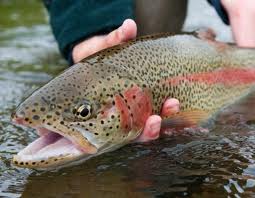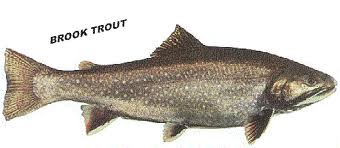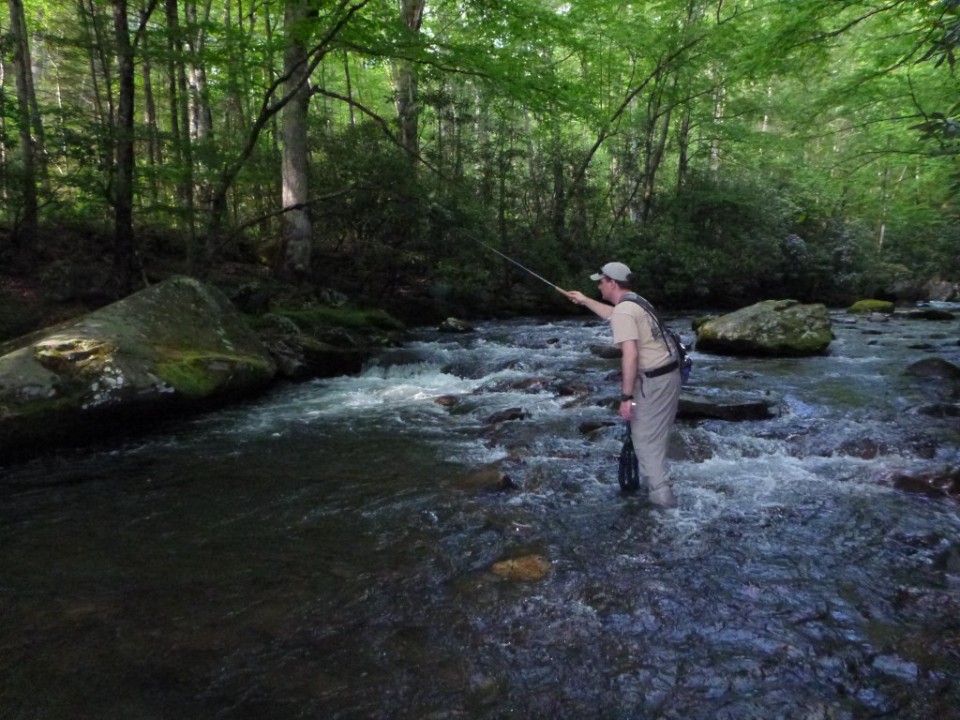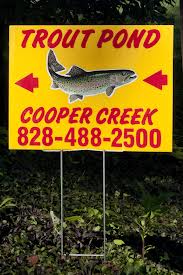Tom Randles recounts an experience on the Nantahala River, and describes why, if forced to choose only one of the many streams and rivers he has had the good fortune to fish, he would choose the “Land of the Noon-day Sun”.
 It was early October, and it was one of those bad news-good news things. The bad news was that the yellow jackets were out in force. They were everywhere, searching for food for those precious grubs carefully stashed in nests underground. One footfall in the wrong spot brings the highly protective and purely vindictive adults swarming in defense of the little ones. Those of us who have inadvertently triggered such a firestorm know it is the kind of excitement that will ruin your day. Absolutely.
It was early October, and it was one of those bad news-good news things. The bad news was that the yellow jackets were out in force. They were everywhere, searching for food for those precious grubs carefully stashed in nests underground. One footfall in the wrong spot brings the highly protective and purely vindictive adults swarming in defense of the little ones. Those of us who have inadvertently triggered such a firestorm know it is the kind of excitement that will ruin your day. Absolutely.
The good news was—well, that the yellow jackets were out in force. Their quest for grub chow took them anywhere the aroma of decay—vegetable or animal—guided them. Their search pattern extended to the water’s edge and beyond. Overhanging bushes provided resting spots and mud and other goodies along the bank produced a smorgasbord for the yellow-orange and black beasties. Occasionally, just often enough, they dropped, fell, stumbled or crash-landed in water. Water, in this instance, meant the tumbling, surging Nantahala River. Once in the water they would be swept away to become part of the food chain.
The Nantahala River was appropriately named “place of the noon-day sun” by the native Cherokee because of the sheer rock walls that soar for hundreds of feet above the river blocking the sun’s rays except for an hour or so before and after high noon. Located in northwest North Carolina, the river has its genesis high in the Nantahala Mountains at Rainbow Springs between Rattlesnake and Doe Knobs at an altitude of nearly four-thousand feet. It then flows ice-cold and clear over garnet studded rocks to Nantahala Lake. The Nantahala Tunnel draws water from the lake bottom to a generating plant near Beechertown, over six miles distant. There, through an agreement between the power company and a dozen score of white-water rafting companies, the Nantahala flows at several thousand cubic feet per second, to provide a white-water experience for rafters and kayakers for most of the daylight hours. It is here, when the water is off, when the discharge tubes are silent, that there are trout to be caught: browns, rainbows and brookies, some large, and a few, leviathans of the trout world. They are not easy, but they are there.
I stood quietly on the swinging bridge above the river, content to watch the water upstream. Like always, I hoped the fish would be “looking up”—rising to take an emerging dun—or struggling terrestrial off the surface. As it is most of the time. the rise was not to be; but a flash in a two foot by four foot pocket told me that the trout were there, feeding.
I strung up my rod, a 7 1/2 foot Winston graphite of an early generation. A three weight, its action was almost as soft as a bamboo, perfect for fishing nymphs and drowned terrestrial mimics. I pulled a nine-foot compound tapered leader with a 5x tippet off my reel and strung it through the guides. Following the leader was a double-taper two-weight silk line, ungreased. I prefer silk to synthetics because of its much smaller diameter for any given weight line, and because of its neutral buoyancy if left untreated. My rod strung, I again turned my attention upstream and waited. Another flash, this time at the head of a small pool almost directly beneath the bridge. I could actually see the fish and identify it as a brookie by its black, red and white caudal fins. At that moment, it finned backward a foot and either spotted me or sensed my presence and disappeared in a nanosecond. About that time a yellow jacket introduced himself to my nose, and I recoiled, forgetting temporarily about trout as I fought to stay upright on the now violently swaying bridge. O.K., I thought, why not tie on a plausible facsimile of the bug that had just buzzed me—a kind of revenge by proxy. I would fish a yellow hammer wet, drowned as it were. Actually, I would fish two of them, tied on in tandem, both artificial artificials.
 The yellow hammer is both a traditional Smoky Mountain fly pattern and a bird. The flying version of the yellow hammer, pronounced “yaller hammer” by local mountaineers, is actually the yellow shafted flicker, a member of the woodpecker family adorned with primary wing feathers that sport golden yellow fibers lined with black. Imminently practical, the local fishermen seized upon the yellow and black of the yellow-hammer feather as an excellent way to imitate the noisome yellow jacket as well as a variety of hornets and wasps. The origin of the yellow-hammer fly is unknown. Even the older local fishermen with whom I’ve spoken about the yellow hammer say only that the fly has been in existence for as long as they can remember.
The yellow hammer is both a traditional Smoky Mountain fly pattern and a bird. The flying version of the yellow hammer, pronounced “yaller hammer” by local mountaineers, is actually the yellow shafted flicker, a member of the woodpecker family adorned with primary wing feathers that sport golden yellow fibers lined with black. Imminently practical, the local fishermen seized upon the yellow and black of the yellow-hammer feather as an excellent way to imitate the noisome yellow jacket as well as a variety of hornets and wasps. The origin of the yellow-hammer fly is unknown. Even the older local fishermen with whom I’ve spoken about the yellow hammer say only that the fly has been in existence for as long as they can remember.
The true yellow-hammer fly is tied with one side of a carefully stripped wing primary. The barbules are carefully levered loose from the shaft with a razor blade or a finely tuned pair of fingernails leaving a windable one-sided hackle. There are two basic yellow hammer ties, both fished wet, and often fished as a pair. The first is tied with a weighted, peacock body with the hackle secured at the head and wound backwards, resulting in a fly that resembles the classic gray hackle only with a striking yellow and black hackle at the neck of the fly. The second type, dubbed a twist , calls for a peacock or yarn body with a yellow hammer hackle tied in at the head, palmered backwards and secured near the bend of the hook. This results in the barbules slanting back toward the bend of the hook. The feather is secured at the back of the hook with a few turns of thread. To me, it looks a little messy but as they said in Tobacco Road, “It don’t hurt the runnin’ of it none.” The effectiveness of the yellow hammer, to my mind, is unquestionable. Is it because the comparatively wide barbules more closely resemble insect legs than do chicken hackle? Or could it be because in stripping the quill, some organic material remains to dispense scent into the water when fished? I just don’t know. I do know they work.
Now, remember earlier when I mentioned tying on an artificial artificial? Nope. Not a typo. While the feathers used on the yellow hammer are unquestionably beautiful, they come from a bird that is enjoys protected status in virtually every state where it can be found. Consequently, fishing with a real yellow hammer can generate not only controversy, but potential legal problems. I have heard of fishermen who have lost their supply to Great Smoky Mountain National Park rangers. The good news is that largely as a result of the generally accepted belief that using body parts from an endangered species is a no-no, a local guide and fly tier came up with an acceptable substitute-starling wings dyed yellow. The dun gray of the starling primaries accepts the yellow dye well and the result is kind of a Smoky yellow color. These work nearly as well as the originals—without the guilt.
Wading into the river, I began working pockets, wading upstream as I cast. I would cast once or twice to each pocket and then move on. There is little value in casting more than twice. If there is a fish finning in a pot of pocket water and it is on the feed, it will nail anything resembling a morsel that is on the menu for that given day. The trout will spit it almost instantaneously if it detects that what it has taken is not as advertised. I am not exaggerating when I use the word “instantaneous”. A pocket-water dwelling trout must accept or reject an apparent edible as it rushes by him. There is no decision made in a trout’s rudimentary brain; instinct dictates that something that is of the proper form, size and color be ingested. The take, evaluation, and subsequent rejection of anything bogus occurs so fast that a fisherman using a strike indicator will miss most strikes. Most of the time, when a mountain trout takes and spits, the strike indicator will not even move. If it does, it is extremely difficult to detect in a surging mountain river, because the fly and the indicator are almost always in different currents even though they are only a few feet apart. This results in an unnatural drift of both the fly and the indicator. I don’t use indicators. I rely on a rod-high position, a short line and the sensitivity of ungreased silk line. Many local fishermen use braided twenty pound test backing dyed green or gray as a substitute fly line. It performs every bit as well as my silk line when it comes to detecting the take of a trout and casts nearly as well. I use tapered silk fly line, I guess, because I like conventional fly tackle and because I’m set in my ways. Believe me, the alternative to silk is a lot cheaper and requires a lot less maintenance.
Four pockets after I waded into the river, a twelve-inch rainbow smacked the fly and I smacked him back. Nothing subtle here. Setting the hook quickly is critical in scoring hook-ups in mountain stream angling. The fish put two or three rocks and twenty feet between us before I turned him and led him to my net. I released him and went back to work. At the end of the day, I was tired. Wading the Nantahala is hard work. The combination of rushing water and rocks which resisted the sticking power of my felt shoes takes a toll. I’d taken some very nice fish. The largest was a nineteen-inch hen rainbow, with two more nearly that long to go with her, along with a mixed bag of ‘bows, browns, and brookies numbering almost two score to top things off. The faux ‘hammer had done its work. Obviously, yellow jackets were on the menu.
I’ve had the opportunity to fish a multitude of streams and rivers in my thirty-odd years of pursuing trout, including the spring creeks and limestones of Pennsylvania; the Henry’s Fork, Yellowstone, and Big Born of the American West; chalk streams in Wales and the crystalline waters of New Zealand’s North and South Islands. If I were forced, for some reason, to choose only one to fish for the rest of my days, it would be none of these. If I could choose just one, it would be the one the Cherokees called “The place of the noon-day sun”. And I would fish a yellow-hammer.


 At Cooper Creek you keep whatever you catch. Once they’re caught, the fish don’t get thrown back in for someone else to catch, it’s yours. Cooper Creek staff will also clean the fish for you. Or they’ll show you how if you plan on trying it out for yourself. It’s a very clean operation, from the fish all the way down to the streams they live in. Just make sure that you give yourself enough time to hang out for the whole day, especially if you’re bringing a family or large group to the creek. It’s going to be a lot of fun that you don’t want to miss and won’t forget any time soon.
At Cooper Creek you keep whatever you catch. Once they’re caught, the fish don’t get thrown back in for someone else to catch, it’s yours. Cooper Creek staff will also clean the fish for you. Or they’ll show you how if you plan on trying it out for yourself. It’s a very clean operation, from the fish all the way down to the streams they live in. Just make sure that you give yourself enough time to hang out for the whole day, especially if you’re bringing a family or large group to the creek. It’s going to be a lot of fun that you don’t want to miss and won’t forget any time soon.